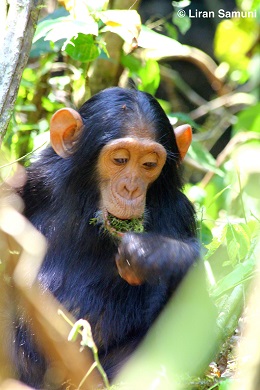Right place, right time for chimpanzee study
 Scientists have, for the first time, witnessed in real-time new behaviour being adopted and transmitted from individual to individual within a wild chimpanzee colony.
Scientists have, for the first time, witnessed in real-time new behaviour being adopted and transmitted from individual to individual within a wild chimpanzee colony.
Scientists from University of St Andrews, Anglia Ruskin University, University of Neuchatel and Universite du Quebec first hand witnessed the spread of two novel feeding methods among the Sonso chimpanzee community living in Uganda’s Budongo Forest.
The results of the real-time discovery, described as ‘extraordinarily rare’, are published in the latest edition of the journal PLOS Biology.
Chimpanzees are widely considered to be the most ‘cultural’ of all non-human animals, but most previous studies examining how behaviour is transmitted have been carried out among captive populations. This is the first time that researchers have tracked in real time how a new natural behaviour was passed from individual to individual in a wild community.
Dr Catherine Hobaiter, Lecturer in Psychology at the University of St Andrews, said: “Researchers have been fascinated for decades by the differences in behaviour between chimpanzee communities; some use tools some don’t, some use different tools for the same job. These behaviours have been described as ‘cultural’, which in human terms would mean they spread when one individual learns from another; but in most cases they’re long established and it’s hard to know how they originally spread within a group.
“We were incredibly lucky to be in the right place at the right time to document the appearance and spread of two novel tool-use behaviours, something that is extraordinarily rare in the wild.”
The researchers in this new study investigated the spread of two variations of “leaf-sponging” which is a common behaviour among chimpanzees. The Sonso chimpanzees typically manufacture leaf-sponges by folding and chewing leaves in their mouth, and then dip them in a water source to drink.
During six days of continuous observation, various individuals were observed to develop two novel behaviours: leaf-sponge re-use, which is using a sponge that had been left from a previous visit, and moss-sponging, which is the production of a sponge made of moss or a mixture of leaves and moss. Neither moss-sponging nor leaf-sponge re-use had been previously observed in the Sonso community.
The analysis began when the group’s 29-year-old alpha male made a moss sponge and began extracting water while being observed by an adult dominant female. Over the next six days the waterhole was revisited regularly and the scientists observed a further seven individuals making and using moss sponges. It was confirmed that six of these had observed the behaviour before adopting it themselves, the seventh was seen to re-use a discarded moss sponge so may have learned about the novel behaviour in this way.
The scientists also recorded a 12-year-old sub-adult male retrieve and use a discarded leaf sponge. A further eight individuals adopted this technique, but only four of them first observed another individual performing this behaviour.
By using a technique called network-based diffusion analysis it is estimated that each time they observed moss-sponging, “naïve” individuals enhanced their chances of developing moss-sponging by a factor of 15. This striking effect contrasted with the re-use behaviour in which social learning seemed to play much less of a role. As the two behaviours occurred at the same time in the same location, the researchers could rule out many alternative explanations, greatly strengthening the case for social transmission of the moss sponging.
The study indicates that group-specific behavioural variants in wild chimpanzees can be socially learned, adding to the evidence that this prerequisite for culture originated in a common ancestor of great apes and humans, long before the advent of modern humans.
Ends
NOTES TO NEWS EDITORS
The paper will be available at: http://www.plosbiology.org/article/info:doi/10.1371/journal.pbio.1001960
Press-only preview: http://www.plos.org/wp-content/uploads/2014/09/pbio.1001960.pdf
Photos are available from the Press Office, contact 01334 462 108
Category Research